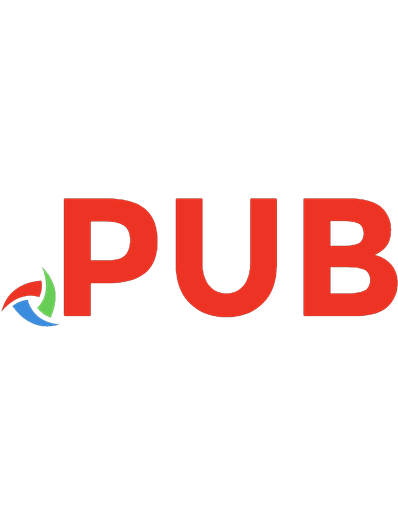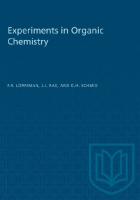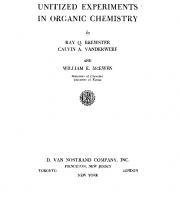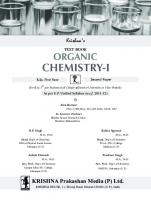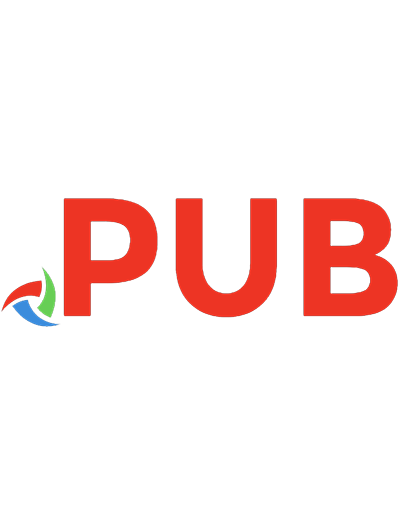Theory and practice of MO calculations on organic molecules (Progress in theoretical organic chemistry) 0444414681, 9780444414687
269 124 15MB
English Pages 378 [396] Year 1976
Polecaj historie
Citation preview
PROGRESS IN THEORETICAL ORGANIC CHEMISTRY VOLUME 1
THEORY AN PRACTICE OF MO CALCULATIONS ON OLECULES ORGAN I. G. Csizmadia
iplHp |BpBl p f .1111 Elsevier
PROGRESS IN THEORETICAL ORGANIC CHEMISTRY VOLUME 1
THEORY AND PRACTICE OF MO CALCULATIONS ON ORGANIC MOLECULES
PROGRESS IN THEORETICAL ORGANIC CHEMISTRY VOLUME 1
THEORY AND PRACTICE OF MO CALCULATIONS ON ORGANIC MOLECULES
I.G. CSIZMADIA Department of Chemistry University of Toronto Toronto, Ontario Canada M5S 1A1
ELSEVIER SCIENTIFIC PUBLISHING COMPANY Amsterdam — Oxford — New York 1976
ELSEVIER SCIENTIFIC PUBLISHING COMPANY 335 Jan van Galenstraat P.O. Box 211, Amsterdam, The Netherlands AMERICAN ELSEVIER PUBLISHING COMPANY, INC. 52 Vanderbilt Avenue New York, New York 10017
The Library University of Regina
ISBN: 0-444-41468-1 Copyright © 1976 by Elsevier Scientific Publishing Company, Amsterdam All rights reserved. No part of this publication may be reproduced, stored in a retrieval system, or transmitted in any form or by any means, electronic, mechanical, photocopying, recording, or otherwise, without the prior written permission of the publisher, Elsevier Scientific Publishing Company, Jan van Galenstraat 335, Amsterdam Printed in The Netherlands
PREFACE
!>
There it.
is
This means
only one way to learn something that
on organic molecules.
begin.
by doing
the road to knowledge in theoretical
organic chemistry is built
organic chemist has
....
from quantum chemical computations
It is hoped that after an experimental
finished this book he will be ready to
Even if he feels he
is not ready,
he should st6rt and
after some computational experience has been gained the con¬ tent ~f
this
introductory book will mean considerably more.
V
TO MY PARENTS
ACKNOWLEDGEMENTS
This book has lectures
emerged from a series of seminars,
and graduate courses
the period 1965-1975
the author has delivered during
at three Canadian Universities:
University of Alberta, Queen's
University,
Edmonton
Kingston
University of Toronto,
The and S.
author is
Wolfe
as well
Toronto
indebted to Professors 0.
P.
Strausz
as
G.
Mezey for
to Drs.
E.
Lown and P.
reading parts of the manuscript during the early period of its preparation. The assistance of John D.
Goddard during the
period of manuscript preparation is Without his
conscientious
"final"
gratefully acknowledged.
efforts it would have been impossible
to finish this manuscript on time. Thanks
are also due to Frank Safian for the art work,
to John Glover for the photography and to Patti Epstein for typing the manuscript. Most of the various projects
computed results,
applications of MO theory,
used to illustrate the
emerged from research
financially supported by the National Research
Council of Canada.
4
*
'
TABLE OF CONTENTS
A. INTRODUCTION
B.
I
Introductory Remarks
II
Mathematical Introduction
III
Quantum Mechanical Background
1
’
6 45
THEORY OF CLOSED ELECTRONIC SHELLS
77
77
IV
Non-Empirical or Hartree-Fock MO Theory
V
Semi-Empirical MO Theories
VI
Excited and Ionized States
117 in the Framework
of Closed Shell MO Theories VII
Hybrid Atomic Orbitals
(HAO)
Localized Molecular Orbitals VIII IX
150 and (LMO)
Limitations of Molecular Orbital Theories Applications
187
of MO Theory to Closed Shell
Problems
212
C. THEORY OF OPEN ELECTRONIC SHELLS
X
Open Shell SCF Theories
XI
Limitations
269
269
and Applications of Open Shell
SCF Theories
D. PRACTICAL ASPECTS
Sets
(jD 158
284
OF MO COMPUTATIONS
for Molecular Orbital Calculations
307
XII
Basis
XIII
Information on Selected Computer Programs
325
XIV
Closing Remarks
352
E. APPENDIX
XV
307
365
Detailed Formalisms of Roothaan's SCF Theories
365
\
V
V
SECTION A
INTRODUCTION
CHAPTER I
INTRODUCTORY REMARKS
/ 1
The Role of Theories
and Models
/
2 1.
The
Role of Theories
The way all
and Molecules
following scheme encompasses
in a very general
scientific activity
\
MODEL
THEORETICAL
EXPERIMENTAL
TECHNIQUE
TECHNIQUE
Figure 1-1. A schematic illustration of the interrelationship of experiment, theory and modelling.
It should be noted that THEORY and EXPERIMENT are equally fundamental a rigorous
stage.
in any branch of science
that has reached
MODELS on the other hand are built either on
theoretical and/or experimental observations and are expected to provide a conceptual explanation for
the phenomenon
investigated. When identify the including all
its
implications
"THEORETICAL TECHNIQUE" with its various branches.
tified with all the "Selection Rules", The
chemical
"Rules" we have the
The
are
sought we can
"Quantum Theory" "MODEL"
may be
iden-
in chemistry
such as
the
"Woodward-Hoffmann Rules'"
and the
like.
application of any THEORETICAL TECHNIQUE to a particular
chemical problem is turn produces
carried out through computation which in
the Theoretical
very much the same way as TECHNIQUE tative
leads
(i.e.
numerical)
Observations
the application of an EXPERIMENTAL
to qualitative
numerical)
(i.e.
(i.e.
results.
non-numeric)
or quanti¬
The application of a MODEL
V
in
3 to the
same chemical problem produces qualitative
numerical)
that we have
and possessing them we usually declare
some understanding of the problem.
There are at that the
tative
least three things
to be noticed.
results obtained from theory are
from models
always qualitative,
thing to notice
is
while experimental
intellectual
constructs while
is
that there exists a v/hole spectrum of
not be trivially obvious this
above viewpoint,
the
in which all of our scientific activities are
confessed opinions 1.
fits.
stage it is necessary to point out that
by no means
the chemical community.
of the
and it need
into which category a construct
unified on an equal basis, in
substances.
constructs between theory and models
At
second
in any chemical
is working with actual chemical
The third point
The
that in both theory and' models we are
dealing with intellectual experiment one
One
always quanti¬
results may be either qualitative or quantitative.
ance
non-
results which may be regarded as concepts or con¬
ceptual explanations
is
(i.e.
Only MODELS
into
In
enjoys uniform accept¬
fact,
we may classify most
the following four categories.
and therefore Conceptual
Explanations
are of any importance and therefore of any real relevance to chemistry because THEORY is incomprehensible 2.
THEORY is
largely
and consequently irrelevant.
important in
so far as
it supports
a
useful MODEL. 3.
THEORY
is of primary importance and a MODEL is
acceptable only in so far as
it is
in close agree¬
ment with the Theoretical Observations. 4.
THEORY
is
the only scientifically acceptable and
therefore relevant method that complements EXPERIMENT.
Consequently all MODELS are more or
less useless
and thus
irrelevant.
Perhaps most experimentalists' fitted in the views
first three categories while most theoreticians'
could be accommodated by the
chemist,
however,
the
last three.
To the average
the relatively moderate views of
are most appealing and the extreme;
point of view could be
(2)
first and last statements
and
(3)
appear
first one being at the ultra conservative extreme
t *
4 while the last is be appropriate
at the radical
extreme.
At this
stage it may¬
to make an operational distinction between
theory and a model.
Such a distinction may be made in terms
their applicability.
If we apply a Theory to investigate
of
a
question that asks WHAT we may compute an answer within any quantitative theory. geometry of NH^?
For example:
We may obtain r(N-H)
Alternatively we may ask: inversion in NH,?
WHAT is
We may compute
theory can answer a question: is
WHAT is the most stable =
1.01 8 and
since
S. .
^ 0
n
n
E
E
i=l
j=l
=
n
n
E
E
a . 6. .b .
i ID
=
E
a.b.
li
3
= a,b,
+ a„b_
11
2 2
+
i=l
a b n n {11-28}
i=l
j=l
The
last part of this equation is the usual expression
one defines the i.e.
n
inner product in terms of vector components,
in terms of the coefficients of the If the vectors
are not real but complex then the
appropriate complex-conjugate {11-26-28}
as
linear combination.
should be used in equations
indicated below.
n
n
HII 1—1
i=l
a.*S..bj l i] 3
{II-27a}
n vector space are real
some
the Euclidean vector The basis vectors of the
and the basis vectors of the
Hermitian vector space are complex so that the Euclidean vector
17 space
is
a special case of the Hermitian vector space.
characteristics of the two spaces
The
are best illustrated in terms
of the properties of the inner product of two vectors: Euclidean Vector Space
Hermitian Vector Space
a)
a)
The
inner product is real:
The inner product is com¬
plex
=
t a2^2
• • • •
=
(a^ *b
+ a2*b2 +
, b)
The
metric
inner product is (i.e.
it is
b)
sym¬
{II-29a,b)
The inner product is
Hermitian
equal to
(i.e.
it is
its own transpose)
to its own adjoint)
‘!’ = =
....
equal
= lx> {ll-30a,b}
c)
The
c)
inner product is
The
inner product is
bilinear
bilinear
+
=
= +
+
{II-31a,b) d) The norm is positive
d) The norm is positive
N =
N =
0
following figure
)>
>
{II-32a,b}
0
illustrates by 3 dimensional geometrical
analogues the Euclidean
(real)
vector space.
X3
^3
An orthogonal 3D- Euclidean vector space
A general
3D-Euclidean vector space
l
Figure
4.
II.7 Geometrical illustrations Euclidean vector spaces.
Matrices When real
or complex scalars
tangular array the resulting object matrix consisting of m-rows The
for
i,
jth.
are arranged is
called a matrix.
and n-columns
element of the matrix is
in a rec¬ A
is an m x n matrix.
found at the intersection
18 . th
A
., and the
=
. th column. j
11
a12
a13
a14
21
a22
a23
a24
31
a32
a33
a34 /
A square matrix has the
1
b12
b13
b21
b22
b23
b31
b32
b33
\
case there
is
x 4 matrix
{11-33}
and columns.
a 3 x 3 matrix
{11-34}
a unique
off diagonal elements.
The diagonal elements
fall on the principal diagonal of the all other elements
a 3
same number of rows
/bll
=
^
(i.e.
b^,
i^j)
square
are those that (i.e.
b.
n
)
while
are called off-diagonal
elements. The
sum of the diagonal elements of a square matrix is
usually referred to as the trace of the matrix tr)
and it is of
some
importance
(abbreviated as
in quantum chemistry
n tr B
=
b. .
E
{11-35}
li
i=l
The multiplication of matrices in computational quantum chemistry.
is
of great importance
Suppose we wish to multi¬
ply matrix B with matrix A defined in equations {11-33}
{11-34}
and
respectively to obtain a product matrix C
2
=
I 5
{11-36}
The elements of C are defined as:
\
19 n c . . ID
£
b .. a, . lk k;j
{11-37}
k=l
This means that the elements of the
ibb row in B
plied by the corresponding elements of the j the sum of these corresponds to the matrix £.
This
is
th
are multi-
column in A and
i,jbb element of the product
illustrated for C2
3 in the next two
equations
C13
ciA
C21
C22
C23
C24
C32
C33
C3V
=
—
fh 11
b12
1—1
c 12
1 1 CO
/cll
b21
b22
b23
\b31
b32
b33/
/all
a12
a13
a14\
a21
a22
a23
a24
\a31
a32
a33
a3 4 / {11-38}
C2 3 From the
b21a13
+
b22a23
+
{11-39}
b23a33
foregoing it should be evident that not any two matrices
may be multiplied together and even two matrices which may be multiplied together in one particular order might not be multi¬ plied in the reverse order. plied but B many columns
.
For example A
£ may be multiplied. as many rows
are
This
A
(3x4)
(3x3)
(3x4)
(nxm)
(nxk)
(kxm)
=
B cannot be multi¬
is because B has
so
in A.
S
C
.
{11-40}
Even if one deals with square matrices
the order which they are
multiplied together is quite
since A.B is not necess¬
arily the
important
same as B.£:
A. B
1
B A
{11-41}
20 There are some
special matrices
used in computational quantum chemistry.
that are frequently These
are the
following. A Diagonal Matrix is
a square matrix with non-zero diagonal
elements and with all other elements being zero.
{11-42}
A Unit Matrix is elements.
a special case of D with unit diagonal
Naturally all off-diagonal elements
are
zero
{11-43}
Multiplication of a matrix with unit matrix leaves the matrix unchanged.
Also in this
case the order of multiplication
is
immaterial.
B
.
1
=
A Null Matrix is a matrix
1
.
B
=
B
{11-44}
(may or may not be a square matrix)
which has only zero elements
0
O
0
{11-45}
0
The
addition and multiplication that
must obey the
following relationships
involves
a null matrix
21
£
+
O
h
k
•
2
2*i
=
2
(for any dimensions)
{11-46}
(for square matrices)
{11-47}
There are certain matrix operations that are used frequently in computational quantum chemistry The Complex Conjugate.
If the elements of Matrix A are complex
then the complex conjugate of the matrix
(£*)’ may be generated
by taking the complex conjugate of the elements.
(i*)ij
=
aij *
{11-48}
If the elements of || are real then
/ A*
=
£
.
/
{11-49}
Consequently in this particular case A is a real matrix.
The
transpose of a matrix is obtained by interchanging the rows
and
columns
11 A
a12
21
a22
/all
a13 \
= a23
J
A'
{II-50a,b}
= a?t
\a13
matrix is changed to a matrix
A'
=
(nxn)
a21
a22
a23
3x2 matrix.
the dimension of the matrix remains the same.
/all
a12
a13 ^
a21
a22
a23
\ a31
a32
a33 /
/ =
\
all
a21
a31
a12
a22
a32
a13
a23
a33
\ {11-51}
Note that the diagonal elements remained unchanged and the i,j indices a32 ’
interchanged in such a way that the
2,3 element of A' is
22 In the
case of a
symmetric arrangement when
aij
the transpose of a matrix is
-
aji
{11-52}
the same as the original matrix
A'
=
A
{11-53} V
This type of matrix is usually called a symmetric matrix. the elements of the matrix are real then the matrix referred to as a real
symmetric matrix which has
If
is normally
the
following
property
(A*)'
=
A
or
{II-54a,b} a ij
This matrix is very frequently used in quantum chemistry.
The
transpose complex conjugate is usually called the adjoint and denoted by a dagger:
A+
The
=
(A*) '
Inverse of a Matrix is defined by the
following identity:
{11-55} For example:
£
{II-56a,b}
i
{11-57}
23 The method of matrix inversion will not be discussed here since those matrices whose very special unitary
(g)
inverse are normally required fall into a
category.
These are
the orthogonal
(0)
and the
matrices whose inverse are the transpose and the
adjoint respectively
{11-58}
{11-59}
The
following relationships
should be observed in connection
with the transpose and the inverse of the product of
two
1
can one
=
A~1
/
.B’
.B-1
{11-61}
can be used to discover under what conditions
interchange the order of matrix multiplication
Usually
However,
A*
1—1
These properties
=
a
(k
1)
sin2oc
-
2
a
^k
coscc
since
(k-1)
+ q
COS
CC
{11-116}
2
qrs(k)
= qsr(k_1)
=
tqss(k_1>
- c!rr(k_1)]
COS'c
sin"
+ qrs(k_1)
[cos °=
-
2
sin *
{11-117}
As noted above the purpose of diagonalization is to eliminate the off-diagonal elements must be set equal to
[qs£/k 1')
so that the
last equation
zero
- qrr^k
cos* sin* + qrs^k_1^
[cos2*
-
sin2*]
=
{11-118}
By noting the
following trigonometric relationships
cos* sin*
=
(1/2)sin 2* {II-119a,b}
cos
we obtain the
- (1/2 Iq^^
2
.
2
* - sm *
=
cos
2*
following simplified expression
- qss^k 1^]
sin 2*
- q^ ^k_1^ rs
.
Cos
2* =
0
{11-120}
or,
combining the appropriate terms,
0
39
2q tan 2“
=
(k-1) rs {11-121}
(k-1)
- q ss
rr It is customary to choose the
limiting cases
(k-1)
« within the range of + 45° since in
2« = +90°.
The
45° limit is
appropriate whenever the denominator becomes grr as
- ^ss
‘
The
si
